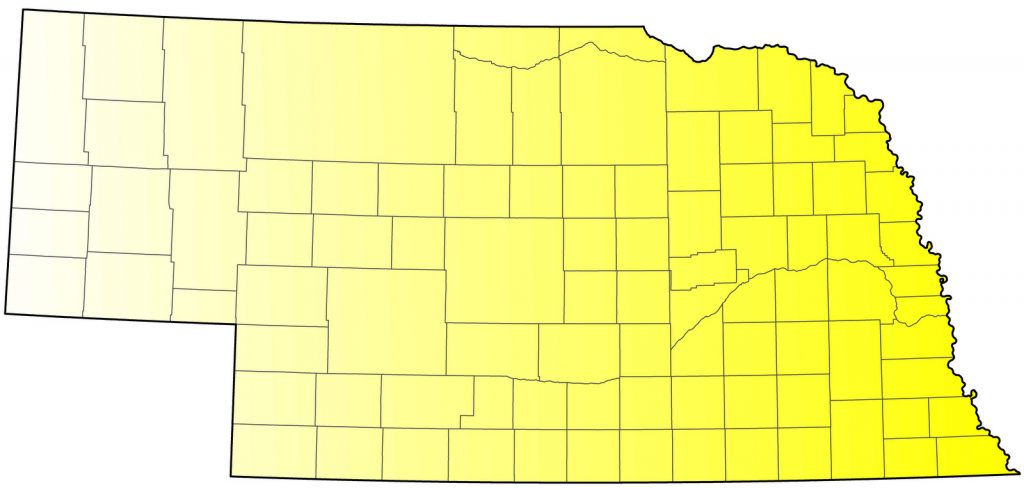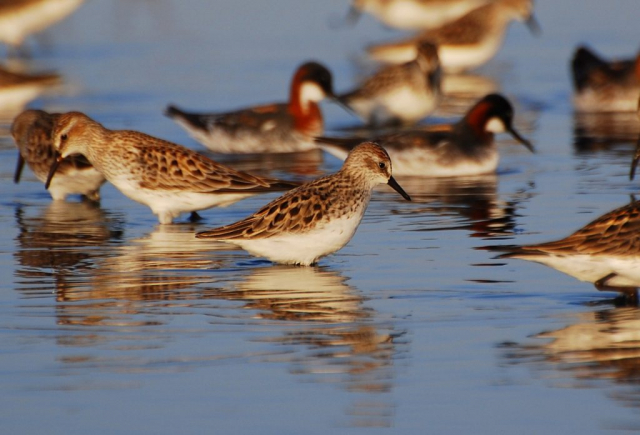Calidris pusilla
Status: Abundant regular spring migrant east and central, fairly common west. Common regular fall migrant east and central, fairly common west. Rare casual statewide summer visitor.

Documentation: Specimen: UNSM ZM6190, 13 May 1901 Gage Co.
Taxonomy: No subspecies are recognized (AviList 2025).
Although no subspecies are recognized, bill and wing lengths exhibit a cline from longest in the east to shortest in the west (Hicklin and Gratto-Trevor 2020). Within this cline three breeding populations are distinguished, each with a characteristic migration route (Gratto-Trevor and Dickson 1994). In spring, migrants through Nebraska appear to include all populations, although few are likely to be from the Eastern Canadian (eastern) population. Of eight spring UNSM specimens, four are from the Alaskan (western) population, three are from the Central Canadian (central) population, and one, a female, by bill length of 21 mm, appears to be from the eastern population. One photographed at North Platte, Lincoln Co 9 May 2019 had been banded 22 Jun 2010 at the Canning River on Alaska’s Arctic Coastal Plain (Ben Lagasse, personal communcation), thus of the western population. In fall, the central and eastern populations migrate eastward to the Atlantic coast and so Nebraska migrants are of the western population; the absence of eastern and central birds results in reduced numbers compared with spring. All of the four UNSM fall specimens are of the western population. Results from a study using geolocators affixed to Semipalmated Sandpipers provide additional evidence that the majority of birds which migrate through Nebraska are from the Alaskan population (Brown et al 2017).
Genetic studies (Miller et al 2013) found insufficient structure to support designation of the three breeding populations as subspecies; differences noted were considered merely reflective of different allele frequencies.
Spring: Apr 6, 7, 7 <<<>>> Jun 16, 17, 17
Earlier dates are 2 Apr 2016 Saunders Co, and 4 Apr 2010 (6) Richardson Co.
Later dates of three or more are considered to be of migrants: 23 Jun 2020 (3) Clay Co. Additional later dates are discussed under Summer.
Migrants usually arrive mid-Apr and peak migration occurs in early May. Semipalmated Sandpipers are still common in late May, when flocks of Calidris sandpipers are dominated by this species and White-rumped Sandpipers. Higher densities apparently move through eastern sections of Nebraska, where the highest counts have been recorded in the eastern Rainwater Basin. West of Clay Co concentrations do not reach the same levels.
- High counts: 3500 in the eastern Rainwater Basin 4 May 2008, 3300 at Harvard WPA, Clay Co 30 Apr 2005, 2000+ in the eastern Rainwater Basin 13 May 2014.
- In the west, 227 were north of Antioch, Sheridan Co 15 May 1998, 190 were at Lake Ogallala, Keith Co 29 Apr 2017, and 148 were at Winters Creek Lake, Scotts Bluff Co, 10 May 2003.
- An amazing total of 7600 was reported in the eastern Rainwater Basin 30 Apr-9 May 2005 (Jorgensen 2012).
Summer: Late Jun dates of 1-2 birds are probably one-year-old birds that discontinued their migration. These are: 21 Jun 2005 Lake McConaughy, Keith Co, 22 Jun 2008 Fillmore Co, 23 and 30 Jun 2017 Jack Sinn WMA, Lancaster Co, 25 Jun 2000 eastern Rainwater Basin, 27-28 Jun 2020 (2) Lancaster Co, and 29 Jun 2001 Lake McConaughy.
Fall: Jul 1, 2, 2 <<<>>> Oct 12, 13, 14
Early dates above are of three or more birds presumed to be migrants. Late Jun records are discussed under Summer.
Determination of late fall dates is difficult due to the problem of separation from Western Sandpiper, generally a later fall migrant than Semipalmated Sandpiper. The late dates above and the following later dates are confirmed in eBird (eBird.org, accessed Oct 2023): 17 Oct 2015 Saunders Co, 17 Oct 2021 Lancaster Co, 22 Oct 2012 Dixon Co, 25-27 Oct 2011 Washington Co, 26-27 Oct 2011 (8-12) Cass Co, and 31 Oct 2014 Lincoln Co.
Adults arrive in early Jul and tend not to remain for extended periods. Juveniles begin to outnumber adults by mid- to late Aug. Peak migration numbers occur during the latter half of Jul through the first week of Sep, accounting for nearly 75% of reports. Abundance is much reduced in fall relative to spring, no doubt a result of the absence of the central and eastern Canada populations (see Taxonomy).
- High counts: 462 at Lake McConaughy 28 Jul 2001, 350 at Cedar Vue, Lake McConaughy 9 Sep 2024, 330 at Lake Babcock, Platte Co 22 Aug 1998, and 266 at Lake McConaughy 24 Aug 2007.
Images
Abbreviations
UNSM: University of Nebraska State Museum
WMA: Wildlife Management Area (State)
WPA: Waterfowl Production Area (Federal)
Literature Cited
AviList Core Team, 2025. AviList: The Global Avian Checklist, v2025. https://doi.org/10.2173/avilist.v2025.
Brown, S. C. Gratto-Trevor, R. Porter, E.L. Weiser, D. Mizrahi, R. Bentzen, M. Boldenow, R. Clay, S. Freeman, M.-A. Giroux, E. Kwon, D.B. Lank, N. Lecomte, J. Liebezeit, V. Loverti, J. Rausch, B.K. Sandercock, S. Schulte, P. Smith, A. Taylor, B. Winn, S. Yezerinac and R.B. Lanctot. 2017. Migratory connectivity of Semipalmated Sandpipers and implications for conservation. Condor 119: 207-224.
Gratto-Trevor, C.L., and H.L. Dickson. 1994. Confirmation of elliptical migration in a population of Semipalmated Sandpipers. Wilson Bulletin 106: 78-90.
Hicklin, P. and C.L. Gratto-Trevor. 2020. Semipalmated Sandpiper (Calidris pusilla), version 1.0. In Birds of the World (A. F. Poole, Editor). Cornell Lab of Ornithology, Ithaca, NY, USA. https://doi.org/10.2173/bow.semsan.01.
Jorgensen, J.G. 2012. Birds of the Rainwater Basin, Nebraska. Nebraska Game and Parks Commission, Lincoln, Nebraska, USA.
Miller, M.P., C.L. Gratto-Trevor, S.M. Haig, D.S. Mizrahi, M.M. Mitchell, and T.D. Mullins. 2013. Population genetics and evaluation of genetic evidence for subspecies in the Semipalmated Sandpiper (Calidris pusilla). Waterbirds 36: 166-178.
Recommended Citation
Silcock, W.R., and J.G. Jorgensen. 2025. Semipalmated Sandpiper (Calidris pusilla). In Birds of Nebraska — Online. www.BirdsofNebraska.org
Birds of Nebraska – Online
Updated 10 Jul 2025

